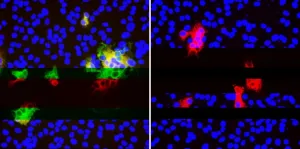INFORMATION:
Eavesdropping marmosets understood other monkeys' conversations - and they judged
Do marmosets understand others' conversations? A thermography approach
2021-02-03
(Press-News.org) Captive marmosets that listened in on recorded vocal interactions between other monkeys appeared to understand what they overheard - and formed judgements about one of the interlocutors as a result, according to behavioral analyses and thermal measurements that corresponded with the marmosets' emotional states. The findings suggest that the eavesdropping monkeys perceived these vocalizations as "conversations" rather than isolated elements and indicate that, on the whole, they prefer to interact with cooperative rather than noncooperative individuals. However, the researchers observed notable differences in how male or female and breeder or helper animals (those without their own offspring) reacted after eavesdropping. While behavioral studies have increasingly offered glimpses into the social lives of primates, they tend to lack reliable measurements of the observer's "inside perspective" - the inner workings of her or his mind. To delve into the minds of snooping marmosets, Rahel Brügger and colleagues presented 21 captive-born adult marmosets with recordings of an opposite sex adult making either food-offering calls or aggressive chatter calls in response to begging infants. As controls, the researchers also played back each call individually. They then assessed changes in the marmosets' nasal temperatures, which correspond with changes in the autonomous nervous system that accompany shifting emotional states. Since the marmosets showed different subtle temperature changes in response to the holistic encounters than to their individual components, Brügger et al. concluded that the monkeys perceived them as conversations. Female and male helpers displayed the strongest emotional responses, but in different ways. Female helpers showed steep temperature drops (indicating strong emotional reactions) after listening to both positive and negative interactions between a male adult and a baby, while male helpers showed temperature increases after listening to negative interactions or to an individual playback of an adult female. Next, the researchers tested whether the monkeys preferred the cooperative, food-sharing individuals or the noncooperative ones by opening both testing compartment doors from which the recordings had been played. Overall, marmosets were less likely to enter the compartment from which they had heard the negative interaction, suggesting that they tend to prefer cooperative individuals. However, the authors note that the behavioral expression of this preference is very context-specific, with marmosets appearing to weigh social costs before acting.
ELSE PRESS RELEASES FROM THIS DATE:
Smartwatch sensors enable remote monitoring & treatment guidance for Parkinson's patients
2021-02-03
Scientists have developed a monitoring system based on commercial smartwatches that can detect movement issues and tremors in patients with Parkinson's disease. The system was tested in a study involving 343 patients - including 225 who the researchers followed for 6 months. The system gave evaluations that matched a clinician's estimates in 94% of the subjects. The findings suggest the platform could allow clinicians to remotely monitor the progression of a patient's condition and adjust medication plans accordingly to improve outcomes. Parkinson's disease is marked by a breakdown in voluntary movement ...
Impact of spokesperson identity on sharing of public health messages
2021-02-03
Participants in an international survey study reported greater willingness to reshare a call for social distancing if the message was endorsed by well-known immunology expert Anthony Fauci, rather than a government spokesperson or celebrity. Ahmad Abu-Akel of the University of Lausanne, Switzerland, and colleagues Andreas Spitz and Robert West of the École Polytechnique Fédérale de Lausanne, report these findings in the open-access journal PLOS ONE on February 3.
Previous research has extensively explored how to maximize the effectiveness of public health messages by altering their style and content. However, relatively few studies have examined the impact of spokesperson identity on the effectiveness of health messages, especially during crises like the ongoing COVID-19 ...
Forming sound memories: Autism gene plays key aspect in birdsong
2021-02-03
DALLAS - Feb. 3, 2021 - Inactivating a gene in young songbirds that's closely linked with autism spectrum disorder (ASD) prevents the birds from forming memories necessary to accurately reproduce their fathers' songs, a new study led by UT Southwestern shows.
The findings, published online today in Science Advances, may help explain the deficits in speech and language that often accompany ASD and could eventually lead to new treatments specifically targeting this aspect of the disorder.
Study leader Todd Roberts, Ph.D., associate professor of neuroscience and a member of the Peter O'Donnell Jr. Brain Institute at UT Southwestern, explains that the vocalizations that comprise a central part of human communication are relatively unique among ...
Scientists propose new way to detect emotions using wireless signals
2021-02-03
A novel artificial intelligence (AI) approach based on wireless signals could help to reveal our inner emotions, according to new research from Queen Mary University of London.
The study, published in the journal PLOS ONE, demonstrates the use of radio waves to measure heartrate and breathing signals and predict how someone is feeling even in the absence of any other visual cues, such as facial expressions.
Participants were initially asked to watch a video selected by researchers for its ability to evoke one of four basic emotion types; anger, sadness, joy and pleasure. ...
BU study: New vaginal film, MB66, is safe
2021-02-03
(Boston)-- While a number of topical products designed to reduce the occurrence of sexually transmitted infections have been tested with largely disappointing results, researchers at Boston University School of Medicine (BUSM), Alpert Medical School of Brown University and Mapp Biopharmaceutical have now found that MB66, a vaginal film product containing monoclonal antibodies against human immunodeficiency virus-type 1 (HIV-1) and herpes simplex viruses types 1 and 2 (HSV-1 and 2), is safe and effective.
HIV-1 and HSV-1 and 2 are relatively common sexually transmitted infections associated with significant illness and sometimes even death. Though antiviral drugs can suppress viral concentrations and dramatically slow ...
Marmoset monkeys eavesdrop and understand conversations between other marmosets
2021-02-03
Humans continuously observe and evaluate interactions between third parties to decide with whom to interact in the future. But it is difficult to measure what information animals gain when they eavesdrop on vocal interactions between conspecifics: If they do understand such conversations, they do not necessarily exhibit behavioral expressions that can be easily observed. To overcome this hurdle, anthropologists from the University of Zurich created a study combining call simulations, thermography methods and behavioral preference measures.
Using thermal imaging, the researchers were able to non-invasively measure temperature changes in the faces of marmoset monkeys to quantify ...
3D-printed bioresorbable airway stent
2021-02-03
Narrowing of the trachea or the main bronchi due to injury or illness can end very badly. If patients get too little air,oxygen, they risk suffocating and often need medical help as quickly as possible.
Surgeons insert stents made of medically usable silicone or metal as a way of treating these patients. Although they quickly bring relief, the implants also have disadvantages: Metal stents have to be removed surgically with some effort, which is a burden for the patients, while silicone stents often migrate away from the insertion site. The reason for this is that the implants are not adapted to a patient's anatomy.
An ETH Zurich research team, composed of members of the Complex Materials and Drug Formulation and Delivery groups, has now developed an ...
Pioneering technique paves way for fast and cheap fabrication of rapid medical diagnostic tools
2021-02-03
New technology developed by the University of Bristol has the potential to accelerate uptake and development of on-chip diagnostic techniques in parts of the world where rapid diagnoses are desperately needed to improve public health, mortality and morbidity.
Microfluidic devices underpin lab-on-a-chip (LOC) technologies which are developed to provide the rapid diagnoses at that are needed at point of care (POC) for the swift and effective treatment of many diseases.
Researchers at Bristol have developed a fast, reliable and cost-effective alternative for producing the soft-lithographic moulds used for fabricating microfluidic devices, published in the journal ...
How SARS-CoV-2 mutates to escape antibody binding
2021-02-03
PITTSBURGH, Feb. 3, 2020 - In a recurring pattern of evolution, SARS-CoV-2 evades immune responses by selectively deleting small bits of its genetic sequence, according to new research from the University of Pittsburgh School of Medicine.
Since these deletions happen in a part of the sequence that encodes for the shape of the spike protein, the formerly neutralizing antibody can't grab hold of the virus, the researchers report today in Science. And because the molecular "proofreader" that usually catches errors during SARS-CoV-2 replication is "blind" to fixing deletions, they become cemented into the variant's genetic material.
"You can't ...
Uncovering recurring deletions in SARS-CoV-2 spike protein that drive antibody escape
2021-02-03
Researchers have identified a pattern of deletions in the spike (S) glycoprotein of SARS-CoV-2 that can prevent antibody binding. Virus lineages featuring this mechanism are currently being transmitted between individuals globally, they say. Their results - reported after analyzing nearly 150,000 S gene sequences collected from many parts of the world - exhibit a form of virus "escape" that resulted from a common, strong selective pressure; for example, the authors identified at least nine instances where deletion variants arose in patients whose COVID-19 infections were persistent. So far, the strongest indicator of protection against SARS-CoV-2 appears to be humoral immunity, such as by antibodies, ...
LAST 30 PRESS RELEASES:
First Editorial of 2026: Resisting AI slop
Joint ground- and space-based observations reveal Saturn-mass rogue planet
Inheritable genetic variant offers protection against blood cancer risk and progression
Pigs settled Pacific islands alongside early human voyagers
A Coral reef’s daily pulse reshapes microbes in surrounding waters
EAST Tokamak experiments exceed plasma density limit, offering new approach to fusion ignition
Groundbreaking discovery reveals Africa’s oldest cremation pyre and complex ritual practices
First breathing ‘lung-on-chip’ developed using genetically identical cells
How people moved pigs across the Pacific
Interaction of climate change and human activity and its impact on plant diversity in Qinghai-Tibet plateau
From addressing uncertainty to national strategy: an interpretation of Professor Lim Siong Guan’s views
Clinical trials on AI language model use in digestive healthcare
Scientists improve robotic visual–inertial trajectory localization accuracy using cross-modal interaction and selection techniques
Correlation between cancer cachexia and immune-related adverse events in HCC
Human adipose tissue: a new source for functional organoids
Metro lines double as freight highways during off-peak hours, Beijing study shows
Biomedical functions and applications of nanomaterials in tumor diagnosis and treatment: perspectives from ophthalmic oncology
3D imaging unveils how passivation improves perovskite solar cell performance
Enriching framework Al sites in 8-membered rings of Cu-SSZ-39 zeolite to enhance low-temperature ammonia selective catalytic reduction performance
AI-powered RNA drug development: a new frontier in therapeutics
Decoupling the HOR enhancement on PtRu: Dynamically matching interfacial water to reaction coordinates
Sulfur isn’t poisonous when it synergistically acts with phosphine in olefins hydroformylation
URI researchers uncover molecular mechanisms behind speciation in corals
Chitin based carbon aerogel offers a cleaner way to store thermal energy
Tracing hidden sources of nitrate pollution in rapidly changing rural urban landscapes
Viruses on plastic pollution may quietly accelerate the spread of antibiotic resistance
Three UH Rainbow Babies & Children’s faculty elected to prestigious American Pediatric Society
Tunnel resilience models unveiled to aid post-earthquake recovery
Satellite communication systems: the future of 5G/6G connectivity
Space computing power networks: a new frontier for satellite technologies
[Press-News.org] Eavesdropping marmosets understood other monkeys' conversations - and they judgedDo marmosets understand others' conversations? A thermography approach




